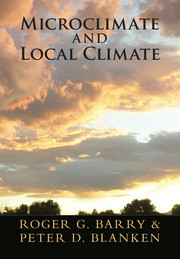Book contents
11 - Topoclimatic Effects on Microclimate
from Part II - Local (Topo-)Climates
Published online by Cambridge University Press: 05 May 2016
Summary
This chapter examines the various effects of topoclimate on microclimates. These include exposition (or aspect), slope angle, and shading, which are all related to incoming solar radiation and thus affect surface and soil temperatures. Exposition and slope angle also modify the wind direction and speed and the precipitation amount. Specific localities such as lakeshores and coasts and spatial subdivisions of urban areas are discussed, as well as mosaic landscapes.
Exposition, Slope Angle, and Shade Effects
Slope exposition (or aspect) has significant effects on solar radiation receipts and, therefore, on surface temperature. One of the earliest investigations of the effects of exposition was carried out in Munich, Germany, by Wollny (1878), who showed that south-facing slopes in the Northern Hemisphere received more radiation and had slightly higher soil temperatures at 15 cm than horizontal surfaces and north-facing slopes. At 560 m elevation in the Inn valley and at 780 m elevation in the Gschnitztal in Austria, soil temperatures were measured by Kerner (1891) at a depth of 70 cm over a three-year period with eight different exposures around a small hillock. The slope angles were not reported. Table 11.1 summarizes a few of his results.
The range of soil temperature with exposition at Inntal (Gschnitztal) in February is 2.9 °C (2.8) and in August it is 4.4 °C (2.3). For the yearly average with exposition the range is 3.2 °C (2.7). The annual range on N slopes is 12.5 °C (13.0) and on SE slopes 15.3 °C (7.1). The snow cover melt date averaged February 21 on the south-facing slope and March 12 on the north-facing slope at Inntal and, correspondingly, on March 25 and April 17 at Gschnitztal.
Cantlon (1953) analyzed microclimates during May 1948–January 1950 on 20° N and S slopes of Cushetunk Mountain, New Jersey, at an elevation of 200 m. He recorded temperatures weekly, or daily during the summer, at 4 cm in the duff layer of the soil, at 5 cm in the bryophyte layer, at 20 cm in the herbaceous layer, 1 m in the shrub layer, and 2 m within the trees to represent the air temperature. The stations were substantially screened by trees, and during summer 1949 two additional slope stations received no direct insolation. Table 11.2 summarizes the differences between south- and north-facing slopes and shade effects for selected months in 1949.
- Type
- Chapter
- Information
- Microclimate and Local Climate , pp. 261 - 274Publisher: Cambridge University PressPrint publication year: 2016



